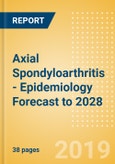Axial Spondyloarthritis - Epidemiology Forecast to 2028
Summary
Axial spondyloarthritis (AxSpA) is a condition characterized by predominant inflammation in the spine and/or sacroiliac joints, with inflammatory back pain and stiffness that may be improved with exercise. Based on sacroiliac changes on conventional radiographs, AxSpA is classified into radiographic (r-AxSpA) or nonradiographic (nr-AxSpA) depending on the presence or absence of radiographic changes at the sacroiliac joints. Patients traditionally classified as ankylosing spondylitis (AS) would be considered as r-AxSpA. Some of nr-AxSpA progress to AS and some do not (Sieper et al., 2002; Kiltz et al., 2012; Wallis et al., 2013). AS has a genetic association with the HLA-B27 risk allele (Sieper et al., 2002; Dean et al., 2014).
The author epidemiologists selected nationally representative population-based studies that provided data for the diagnosed prevalence of AxSpA in the 7MM. the author's epidemiological analysis provides country-specific forecast for the diagnosed prevalent cases of AS and nr-AxSpA in the 7MM during 2018-2028 using two different approaches: forecast based on data obtained through primary market research (PMR) (base scenario), and forecast based on data obtained from secondary research (alternate scenario).
The following data describes diagnosed prevalent cases of AS and nr-AxSpA in the 7MM using base scenario, where the forecast is based on data obtained from PMR. In the 7MM, the diagnosed prevalent cases of AS will increase from 1,393,906 cases in 2018 to 1,788,563 cases in 2028, at an Annual Growth Rate (AGR) of 2.83% and the diagnosed prevalent cases of nr-AxSpA will increase from 1,003,767 cases in 2018 to 1,328,882 cases in 2028, at an AGR of 3.24%.
Scope
Reasons to Buy
The AxSpA Epidemiology series will allow you to -
Summary
Axial spondyloarthritis (AxSpA) is a condition characterized by predominant inflammation in the spine and/or sacroiliac joints, with inflammatory back pain and stiffness that may be improved with exercise. Based on sacroiliac changes on conventional radiographs, AxSpA is classified into radiographic (r-AxSpA) or nonradiographic (nr-AxSpA) depending on the presence or absence of radiographic changes at the sacroiliac joints. Patients traditionally classified as ankylosing spondylitis (AS) would be considered as r-AxSpA. Some of nr-AxSpA progress to AS and some do not (Sieper et al., 2002; Kiltz et al., 2012; Wallis et al., 2013). AS has a genetic association with the HLA-B27 risk allele (Sieper et al., 2002; Dean et al., 2014).
The author epidemiologists selected nationally representative population-based studies that provided data for the diagnosed prevalence of AxSpA in the 7MM. the author's epidemiological analysis provides country-specific forecast for the diagnosed prevalent cases of AS and nr-AxSpA in the 7MM during 2018-2028 using two different approaches: forecast based on data obtained through primary market research (PMR) (base scenario), and forecast based on data obtained from secondary research (alternate scenario).
The following data describes diagnosed prevalent cases of AS and nr-AxSpA in the 7MM using base scenario, where the forecast is based on data obtained from PMR. In the 7MM, the diagnosed prevalent cases of AS will increase from 1,393,906 cases in 2018 to 1,788,563 cases in 2028, at an Annual Growth Rate (AGR) of 2.83% and the diagnosed prevalent cases of nr-AxSpA will increase from 1,003,767 cases in 2018 to 1,328,882 cases in 2028, at an AGR of 3.24%.
Scope
- The Axial Spondyloarthritis Epidemiology Report and Model provide an overview of the risk factors and global trends of AxSpA in the seven major markets (7MM: US, France, Germany, Italy, Spain, UK, and Japan).
- Base Scenario: This report includes a 10-year epidemiological forecast for the diagnosed prevalent cases of AS and nr-AxSpA for both sexes and ages ≥18 years in the 7MM.
- Alternate Scenario: Additionally, a 10-year epidemiological forecast for the diagnosed prevalent cases of AS and nr-AxSpA segmented by age (18-19 years, 20-29 years, 30-44 years, 45-59 years, 60-74 years, 75-79 years, 80-84 years, and 85 years and older) and sex. The report also provides the forecast for diagnosed prevalent cases of AS segmented by HLA-B27 seropositivity status in the 7MM.
- The axial spondyloarthritis epidemiology report and model were written and developed by Masters- and PhD-level epidemiologists.
- The Epidemiology Report is in-depth, high quality, transparent and market-driven, providing expert analysis of disease trends in the 7MM.
- The Epidemiology Model is easy to navigate, interactive with dashboards, and epidemiology-based with transparent and consistent methodologies. Moreover, the model supports data presented in the report and showcases disease trends over a 10-year forecast period using reputable sources.
Reasons to Buy
The AxSpA Epidemiology series will allow you to -
- Develop business strategies by understanding the trends shaping and driving the global AxSpA market.
- Organize sales and marketing efforts by identifying the age groups and sex that present the best opportunities for AxSpA therapeutics in each of the markets covered.
- Understand magnitude of AxSpA by radiographic and nonradiographic population.
Table of Contents
1 Table of Contents
2 Axial Spondyloarthritis: Executive Summary
3 Epidemiology
4 Appendix
List of Tables
List of Figures








